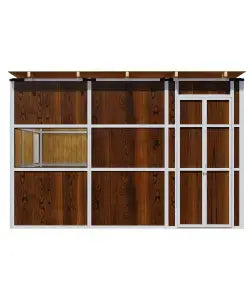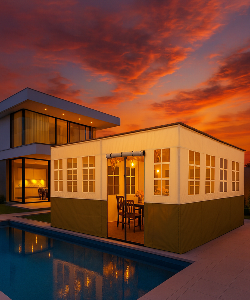How to Prepare for Sukkot: A Step-by-Step Guide for 2026

Figuring out how to prepare for Sukkot can feel overwhelming if you're new to the holiday, but here's the reality: people have been celebrating this festival for thousands of years without Pinterest boards or detailed project management apps. The key is understanding what actually matters versus what just looks impressive on social media.
Quick Start Checklist for Sukkot Preparation
-
Secure a Sukkah Kit: Choose a structure that fits your space; balcony, backyard, or driveway.
-
Order the Four Species: Ensure timely delivery of a kosher lulav and etrog set.
-
Plan Decorations Early: Include lighting, artwork, paper chains, and natural décor.
-
Prep Meals and Serving Tools: Think transportable dishes and outdoor-friendly utensils.
-
Weather-Proof Your Space: Add cushions, insect protection, and lighting for chilly nights.
-
Set a Deadline: Aim to complete setting up a full day before Sukkot eve to reduce stress.
When Can You Start Building a Sukkah?
You can start building your sukkah immediately after Yom Kippur ends. In fact, it's a beautiful tradition that many observe, moving from spiritual reflection on Yom Kippur to physical preparation for the joy of Sukkot.
Why Start Right After Yom Kippur?
The timing allows you to make a seamless spiritual transition. Plus, Sukkot begins just five days later, so getting a head start is wise.
Planning Ahead
While the actual building can wait, having your materials ordered and helpers lined up ensures a smooth setup. Our sukkah kits are designed for easy assembly and ship across the U.S.
Sukkot Eve Essentials
Like most Jewish holidays, Sukkot begins at sundown. Your sukkah should be fully built and decorated by then.
Final Preparations Checklist:
-
Schach (roof covering) is installed securely.
-
Seating and table setup completed.
-
Decorations hung.
-
String lights tested.
-
Blankets and insect repellent are ready.
First Night Meal
Prepare a festive meal that’s easy to serve outside. Use sealed containers or warming trays for convenience. Think brisket, challah, seasonal vegetables, and lots of joy.
The Four Species (Arba Minim) Used on Sukkot
Understanding the four species gets you into one of the holiday's most distinctive rituals. These aren't four different types of sukkahs; they're four species of plants that are used together in daily prayers throughout the festival.
The lulav (palm branch) forms the central spine of the bundle. It should be straight, with its leaves intact and pointing upward. The etrog (citron) is held separately in your left hand; it looks like a large, bumpy lemon and should be unblemished, with its pitom (the small protrusion at the top) intact if possible.
Hadassim (myrtle branches) and aravot (willow branches) are bound to the lulav with special rings or ties. You need at least three myrtle branches and two willow branches, though some traditions use more. The myrtle leaves should be small and densely packed, while the willow leaves should be long and narrow.
Acquiring these four species requires some planning, especially if you don't live in an area with a large Jewish community. Many synagogues organize group orders, and specialty retailers ship complete sets. The etrog, in particular, can be expensive and requires careful handling; it's traditionally kept in a special box to prevent damage.
The ritual itself involves holding the lulav bundle in your right hand and the etrog in your left, bringing them together, and waving them in six directions during specific prayers. It's more choreographed than it might sound, so don't worry if it feels awkward at first.
What Are the Requirements for a Sukkah?
The requirements for a sukkah are surprisingly specific, rooted in centuries of rabbinical interpretation and practical experience. Understanding these rules helps you build something that's not just structurally sound but also spiritually meaningful:
-
Size matters, but not in the way you might expect. A sukkah must be large enough for you to sit comfortably inside; technically, this means big enough for your head and most of your body, plus a small table. There's no maximum size limit, so you can build as large as your space and budget allow.
-
Height requirements are more specific: the walls must be at least 40 inches high, and the total height can't exceed about 30 feet (though most backyard sukkahs are much shorter). The walls don't have to be solid; you can use canvas, bamboo screening, or even decorative panels as long as they provide adequate enclosure.
-
The schach (roof covering) has the most detailed requirements. It must be made from materials that grew from the ground and are now detached from their source. Bamboo mats, palm fronds, pine branches, and corn stalks all work. The covering should provide more shade than sunlight during the day but still allow you to see stars at night.
-
Structural stability is important too. Your sukkah needs to withstand normal weather conditions for your area. This doesn't mean it has to survive a hurricane, but it should be solid enough that you feel comfortable eating meals inside without worrying about collapse.
The key is balancing the requirements with practicality. A sukkah that meets all the technical specifications but is uncomfortable to use defeats the purpose. Focus on creating a space that invites you to spend time outside, eat meals together, and reflect on the temporary nature of all our dwellings.
Ready to Start Your Sukkot Preparations?
Sukkah Market provides everything you need, from bamboo schach mats to comprehensive sukkah building instructions. Even if you're interested in decorating a sukkah or need to contact Sukkah Market for expert guidance, we're here to support your celebration. Learning how to prepare for Sukkot properly ensures that when the holiday arrives, you can focus on what really matters: gathering with loved ones and creating meaningful memories in your temporary dwelling.
Frequently Asked Questions
Can I Build a Sukkah on a Balcony?
Yes, if it has an open sky above and meets size and schach requirements.
How Do I Keep My Sukkah Comfortable?
Add string lights, cushions, warm blankets, and citron-scented candles or bug repellents.
What if I Live in a City or a Small Space?
We offer compact sukkah kits ideal for urban balconies and small patios.
When Should I Order Materials?
Early! Demand increases in the weeks before Sukkot. We recommend ordering at least 2 weeks prior.
Can I Decorate My Sukkah With My Kids?
Absolutely! It’s a beloved family tradition. Hang paper chains, fruits, and posters with Jewish symbols.







